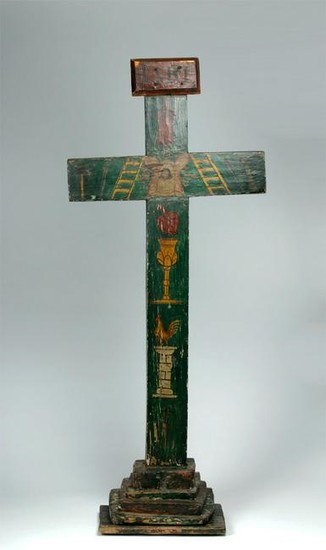Tall / Impressive 19th C. Mexican Painted Wood Cross
**Originally Listed At $2000**
New World, Mexico, ca. 19th century CE. A tremendous wooden cross, handmade and constructed from multiple pieces of wood, painted by a pious folk artist. The cross is painted green, with black-outlined red and yellow motifs around a central figure of Christ, his head dripping blood from the crown of thorns. On either side of him are ladders, spears, and pikes, representing his placement on the cross and the weapons of the Roman guards. Above him is the Seamless Robe of Jesus. Above that is a wooden plaque reading "INRI," meaning, "Jesus of Nazareth, King of the Jews," the sign nailed above Christ's head as He was dying. Below Christ, on the long arm of the cross, is a stylized heart dripping into a goblet, symbolizing the Holy Grail, and below that, a cock on a column. Size: 11" L x 21.3" W x 51.4" H (27.9 cm x 54.1 cm x 130.6 cm)
The latter is a very ancient Christian symbol, representing the cock whose crow signaled that St. Peter had thrice denied knowing Christ. Although on its face this seems to be a condemnation of Peter's actions, it is meant to represent that a person could redeem himself even after committing one of the worst sins imaginable. Early artists, attempting to recreate the Biblical scene, seem to have struggled with where to place the cock - in a tree? on the ground? in an architectural feature? Slowly, through Roman and later Italian funerary sarcophagi carving, artists established a visual shorthand for the scene where the cock stands atop a Roman-style column. The folk artist who created this cross drew on that nearly-two-millennia-old tradition to paint this scene.
Provenance: private Omer Claiborne collection, Santa Fe, New Mexico, USA; acquired over the last 40 years
All items legal to buy/sell under U.S. Statute covering cultural patrimony Code 2600, CHAPTER 14, and are guaranteed to be as described or your money back.
A Certificate of Authenticity will accompany all winning bids.
We ship worldwide to most countries and handle all shipping in-house for your convenience.
#129228
Condition Report: Inactive insect damage on the back, with losses to paint as shown, especially on the back and the base. Colors and artwork are generally nicely preserved, with a good patina from age and handling on exposed wood surfaces, especially the INRI sign at the top.
View it on
Estimate
Time, Location
Auction House
**Originally Listed At $2000**
New World, Mexico, ca. 19th century CE. A tremendous wooden cross, handmade and constructed from multiple pieces of wood, painted by a pious folk artist. The cross is painted green, with black-outlined red and yellow motifs around a central figure of Christ, his head dripping blood from the crown of thorns. On either side of him are ladders, spears, and pikes, representing his placement on the cross and the weapons of the Roman guards. Above him is the Seamless Robe of Jesus. Above that is a wooden plaque reading "INRI," meaning, "Jesus of Nazareth, King of the Jews," the sign nailed above Christ's head as He was dying. Below Christ, on the long arm of the cross, is a stylized heart dripping into a goblet, symbolizing the Holy Grail, and below that, a cock on a column. Size: 11" L x 21.3" W x 51.4" H (27.9 cm x 54.1 cm x 130.6 cm)
The latter is a very ancient Christian symbol, representing the cock whose crow signaled that St. Peter had thrice denied knowing Christ. Although on its face this seems to be a condemnation of Peter's actions, it is meant to represent that a person could redeem himself even after committing one of the worst sins imaginable. Early artists, attempting to recreate the Biblical scene, seem to have struggled with where to place the cock - in a tree? on the ground? in an architectural feature? Slowly, through Roman and later Italian funerary sarcophagi carving, artists established a visual shorthand for the scene where the cock stands atop a Roman-style column. The folk artist who created this cross drew on that nearly-two-millennia-old tradition to paint this scene.
Provenance: private Omer Claiborne collection, Santa Fe, New Mexico, USA; acquired over the last 40 years
All items legal to buy/sell under U.S. Statute covering cultural patrimony Code 2600, CHAPTER 14, and are guaranteed to be as described or your money back.
A Certificate of Authenticity will accompany all winning bids.
We ship worldwide to most countries and handle all shipping in-house for your convenience.
#129228
Condition Report: Inactive insect damage on the back, with losses to paint as shown, especially on the back and the base. Colors and artwork are generally nicely preserved, with a good patina from age and handling on exposed wood surfaces, especially the INRI sign at the top.



